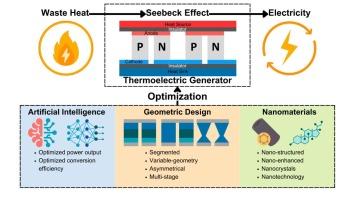A review of next-generation thermoelectric generators: Advanced geometric and nanomaterial optimization and intelligent performance enhancement
IF 7.6
Q1 ENERGY & FUELS
引用次数: 0
Abstract
The demand for sustainable energy solutions has accelerated the development of thermoelectric generators (TEGs) as an effective technology for harvesting waste heat. TEGs employ the Seebeck effect to convert thermal energy into electricity. They offer advantages such as solid-state operation, scalability, and minimal maintenance. However, their widespread implementation is hindered by low energy conversion efficiency. This review comprehensively analyzes the state-of-the-art in TEG technology, focusing on geometric optimization, material enhancements, and AI-driven performance improvements. Innovations in TEG designs, including segmented, variable-geometry, asymmetrical, and multistage architectures, are examined in relation to their impact on power output and efficiency. In addition, the integration of artificial intelligence (AI), computational fluid dynamics (CFD), and nanomaterials in predictive modeling and real-time optimization is discussed. AI-driven strategies such as evolutionary computation and machine learning have demonstrated significant potential in optimizing TEG configurations for maximum efficiency. Despite recent breakthroughs, challenges persist in large-scale implementation, fabrication complexity, and cost-effectiveness. Future research should prioritize the development of high-performance thermoelectric materials, advanced manufacturing techniques, and multi-physics simulation models to facilitate the next generation of TEG applications in waste heat recovery, automotive applications, and renewable energy generation. This review highlights emerging trends and outlines strategic research directions to accelerate the adoption of TEGs in sustainable energy generation.

新一代热电发电机的研究进展:先进的几何和纳米材料优化和智能性能增强
对可持续能源解决方案的需求加速了热电发电机(teg)作为收集废热的有效技术的发展。teg利用塞贝克效应将热能转化为电能。它们具有固态操作、可伸缩性和最少维护等优点。然而,它们的广泛应用受到低能量转换效率的阻碍。本文全面分析了TEG技术的最新进展,重点关注几何优化、材料增强和人工智能驱动的性能改进。TEG设计的创新,包括分段、可变几何、不对称和多级架构,研究了它们对功率输出和效率的影响。此外,还讨论了人工智能(AI)、计算流体力学(CFD)和纳米材料在预测建模和实时优化中的集成。人工智能驱动的策略,如进化计算和机器学习,在优化TEG配置以实现最高效率方面显示了巨大的潜力。尽管最近取得了一些突破,但在大规模实施、制造复杂性和成本效益方面仍然存在挑战。未来的研究应优先发展高性能热电材料、先进制造技术和多物理场仿真模型,以促进下一代TEG在废热回收、汽车应用和可再生能源发电方面的应用。本综述强调了新兴趋势,并概述了加速在可持续能源生产中采用teg的战略研究方向。
本文章由计算机程序翻译,如有差异,请以英文原文为准。
求助全文
约1分钟内获得全文
求助全文
来源期刊

Energy Conversion and Management-X
Multiple-
CiteScore
8.80
自引率
3.20%
发文量
180
审稿时长
58 days
期刊介绍:
Energy Conversion and Management: X is the open access extension of the reputable journal Energy Conversion and Management, serving as a platform for interdisciplinary research on a wide array of critical energy subjects. The journal is dedicated to publishing original contributions and in-depth technical review articles that present groundbreaking research on topics spanning energy generation, utilization, conversion, storage, transmission, conservation, management, and sustainability.
The scope of Energy Conversion and Management: X encompasses various forms of energy, including mechanical, thermal, nuclear, chemical, electromagnetic, magnetic, and electric energy. It addresses all known energy resources, highlighting both conventional sources like fossil fuels and nuclear power, as well as renewable resources such as solar, biomass, hydro, wind, geothermal, and ocean energy.
 求助内容:
求助内容: 应助结果提醒方式:
应助结果提醒方式:


